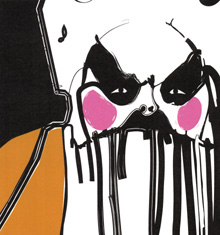Chinese animator says we have a unique style

A detail of Chinese contemporary animation that was used on a poster to advertise He Fei‚s talk.
Visiting professor He Fei, from the Academy of Traditional Opera in Beijing, gave an interesting talk on the history and evolution of Chinese animation last Friday in the De Sève theatre.
He is visiting Concordia as part of a bilateral agreement signed between the two schools last year. He has been enjoying his time at Concordia, studying Canadian styles of animation.
“Canadian animation is like a sacred place for Chinese,” he said. “It represents freedom of creativity and pushes the boundaries of the art form.”
In his lecture, He Fei lamented the encroaching influence Japanese and American animation styles on Chinese studios.
“It is becoming very commercial,” he said.
“Everything is being made to an ‘international standard.’ It looks like second-hand Disney animation.”
Regarding the animated short films that first drew Western attention to Chinese animation in the mid 1980s, he said as more animators have opted to work on bigger, better-paying animated feature films, animated shorts have almost ceased to exist.
“In China right now, there are no personal animation pieces,” he told the crowd. “No one wants to do it.”
Some hope remains, said He Fei. A small community of animators is beginning to produce more personal animated short films, designed to be educational.
He Fei said he was interested in coming to Canada because “the animation here is very high quality. It is unique.” Applying techniques he learns here at Concordia will help him with his teaching back at the Academy. Chinese animation still has a long way to go as an art form, he said.
Concordia currently has bilateral agreements in place with two schools in China, the Academy of Traditional Opera and the Film Academy. The agreements allow students to come to Concordia and study for a term or one year without paying international fees.
Hinton
So far only one student has gone over to China, to the Film Academy. Faculty exchanges are also made possible by the agreements. Animation professor Chris Hinton spent some time in China last fall, learning the techniques used in animation at the Academy of Traditional Opera.
Liselyn Adams, the Associate Dean for Research and Graduate Studies, has been deeply involved in the project.
“It’s growing into an interesting exchange,” she said. “They are curious about the different models (of animation) that exist and want to know how we teach them.” In return, she said, Concordia gets insight in the wealth of art history and the current teaching methods used to teach their art methods.
Adams noted that at the Academy of Traditional Opera, they use animation to study a specific role. “The gestures are incredibly precise,” she said. “Professors will correct a student’s hand gesture, moving a finger a sixteenth of an inch.”
Concordia and the Academy of Traditional Opera will be exchanging performance.
Bradyworks, Concordia’s in-residence music ensemble, go to Beijing in one year to give classes and perform.
In 2006, the Academy’s troupe will come to Concordia. A two-week summer institute will run around Chinese opera, focusing on the preservation of the art form, design and other traditions.